Several weeks ago, we posed a provocative proposition – a jump shot is better than a layup – and set out to prove it. In Part 1, we traced the historic evolution of basketball and how coaching philosophy and strategy differed from one region to the next, but finally collided in the 1930s and 40s when Stanford’s Hank Luisetti and Wyoming’s Kenny Sailors dazzled the country with their one-handed jump shooting. In Part 2, we explored the nature of jump shooting and its dramatic impact on basketball. Now, in this final post on the subject, we’ll offer three proofs for our proposition.
Continue reading…Tag Archives: Austin Carr
Records are made to be broken, but…
Though the 82nd NCAA Tournament has been scrubbed, we can still celebrate the 50th anniversary of Austin Carr’s single-game scoring record: 61 points in the 1969-70 first round game against Ohio University, the Mid-American Conference champion.
Shooting 57% from the field, the 6’3” Notre Dame guard made 25 field goals out of 44 attempts. He nearly duplicated this amazing feat a week later against SEC champion Kentucky and Big Ten champ Iowa scoring 52 and 45 points respectively. His three-game shooting percentage was 58%.
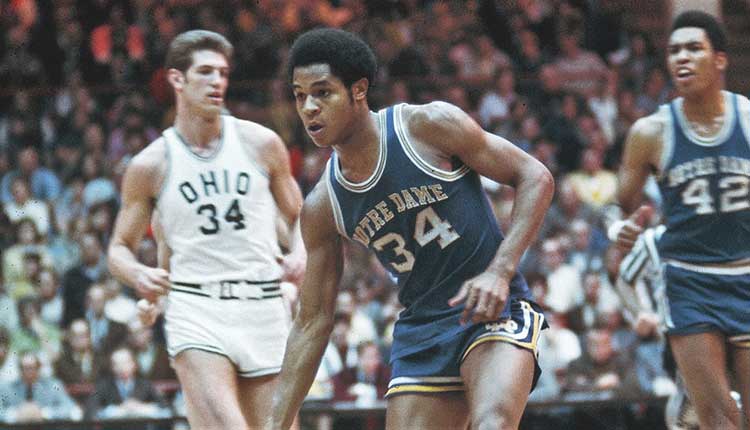
Significantly, he was joined by teammate Collis Jones who averaged 23 points per game in the three contests. Together, they produced 228 points in three successive tournament games — an average of 76 points per game on 54% marksmanship.
For a detailed look at their amazing feat I invite you to visit the piece I posted last week at Hudl.com. You’ll find a highlight film of their two-man, single-game scoring record (85 points) as well as an intriguing comparison with last year’s tournament field.
If you’re interested in seeing the entire game, visit my YouTube channel. Digitized from an ancient Sony reel-to-reel video tape, the game is not only great fun to watch, but is of historic interest as it marks the beginning of the end of one era in college basketball and the launching of the one we now experience. In many ways, it foreshadows how the college game evolved as it grew in popularity, driven by 24/7 cable coverage and the explosion of March Madness.
In the meantime, here are several Krossover charts I constructed to bring analytic definition to the Carr-Jones record, all of it occurring in an era before the 3-point shot.
Chart #1: Traditional Shot Chart: 63 FGA, 34 FG, 54%
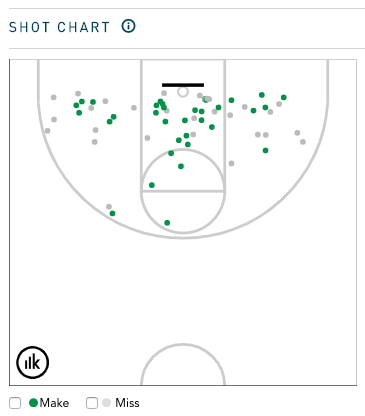
Chart #2: Hot Zone: The Hex Bin Shot Chart shows volume by hexagon size and efficiency by color.
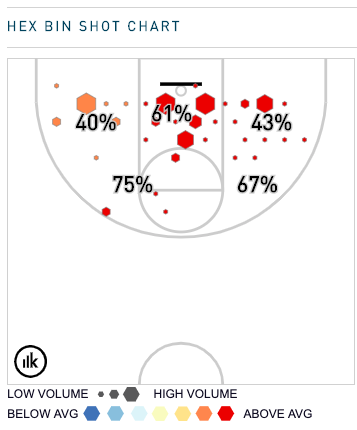
Chart #3: FG% by Distance
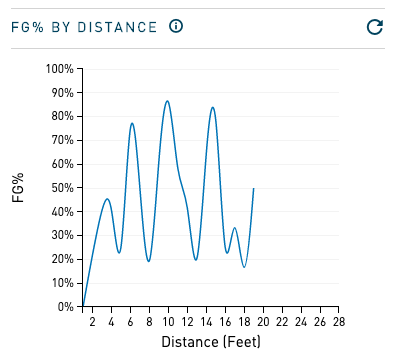
Chart #4: Shot Zone: Midrange: 40 FGA, 20 FG, 50%; Inside 5 Feet: 23 FGA, 14 FG, 61%
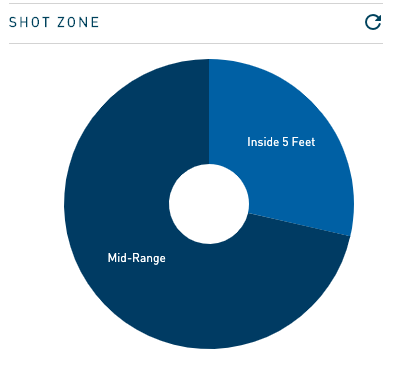
Chart #5: Defensive Contesting Level: Contested: 40 FGA, 22 FG, 55%; Uncontested: 17 FGA, 10 FG, 59%; Blocked: 6 FGA, 0 FG, 0%; Unknown: 2 FGA, 2 FG, 100%
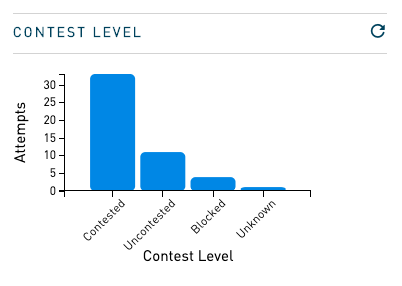
Chart #6: Shot Creation Type: Catch & Shoot Jumpers: 23 FGA, 9 FG, 39%; Off the Dribble Jumpers: 12 FGA,8 FG, 67%; Layup, Dunk, Tip: 27 FGA, 16 FG, 59%; Unknown: 1 FGA, 1 FG, 100%

Chart #7: Offensive Set Up: Half Ct Offense: 42 FGA, 24 FG, 49%; Fast Break: 14 FGA, 10 FG, 71%

By Request
During the last couple of weeks, in response to a series of posts on the decline of scoring in college basketball and my attempt to trace the reasons for this disturbing trend by probing Austin Carr’s record-setting performance in the early 1970’s, several readers have requested information on the Stack or Isolation Offense. Over the weekend I was flattered to hear from basketball aficionado, Herb Welling.
Coach Welling, as you may know, has been called the “minister of information” in coaching circles and has been featured several times in the media, most prominently in Grant Wahl’s 2008 Sports Illustrated article on the evolution of the Dribble Drive Motion offense.
Herb first became acquainted with betterthanalayup.com when researching the matching zone defense and discovered my piece on coach Gene Sullivan’s strategy. In recent days we’ve shared several emails and phone calls, discussing the origins of Sullivan’s equally interesting Stack offense.
I promised him that I would provide a deeper dive into the subject and am pleased to offer it now in a “quick and dirty,” Q & A format. In the future I’ll post a more comprehensive and polished essay.
In the meantime, I hope this initial piece proves helpful and prompts further questions and commentary.
Click here to read Stack Offense Q & A
Time Machine
Let’s go back.
In fact, let’s go back forty-five years to an era of college basketball retired sports columnist Mike Loprestti fondly remembers.
“There was no shot clock, no three-pointers and no complaints about lack of scoring. Jacksonville put up 109, 104, 106, and 91 points on its way to the 1970 championship game that it lost to UCLA. Who knew that the more they put in rules friendly to the offense, the lower the scores would go?”
That same year I sat on the Notre Dame bench as the Irish student trainer and witnessed first-hand that historic tournament game I referenced in my last post. The one in which Austin Carr set the single-game tournament scoring record, garnering 61 points against Ohio University in the first round of the 1969-70 tournament.
Today, captured on ancient video tape, the game is not only great fun to watch but is of historic interest as it marks the beginning of the end of one era in college basketball and the launching of the one we now experience. In many ways, it foreshadows what the game was to become and how it began to deteriorate even as it grew in popularity driven by 24/7 cable coverage and the explosion of March Madness. Here’s a quick rundown of what the game tape reveals: Continue reading…
The Blind Men and the Elephant
It’s over… finally. Much of it unwatchable. The slowest, lowest scoring collegiate season since 1981-82. In fact, you’d have to go back 64 years to 1951-52 to find a less productive season. That’s an era when many players still relied on two and one-handed set shots.
The tournament, of course, presented many of the old delights – the “combination of upsets, buzzer-beaters, frenzied comebacks, court-storming, dancing, and weeping” recently noted by ESPN’s Brian Phillips – but also contributed to the season-long agony of pushing and shoving, interminable timeouts, coaches prowling the sideline, often straying onto the court, jump shots clanging off the rim… well, you get the picture.
- According to analytics expert Ken Pomeroy, three of this year’s Final Four teams ranked outside of the top 200 in tempo. The lone exception? Duke ranked No. 114.
- In its semi-final game against Duke, Michigan State scored 14 points in the first 3:42 of play followed by only 9 points in the remaining 16:18 of the half. Duke advanced to the finals on the back of 27 free throws and 26 field goals in 40 minutes of competition. That’s an average of one basket every 90 seconds.
- Forty-eight hours later, the halftime score of Duke’s national championship game with Wisconsin ended 31 apiece. In the 1988 matchup, Kansas and Oklahoma battled to a 50 – 50 tie in the same period of time, collectively outscoring this year’s stalwarts, including nine McDonald’s All Americans, three of whom are surefire one-and-doners, by 38 points.
- The final five minutes of the Duke – Wisconsin brawl took 18:41 minutes of real time to play.
To place the dismal offensive performance of this year’s tournament in historical perspective, consider the following: Continue reading…
